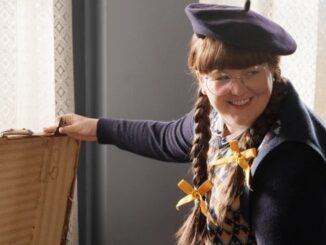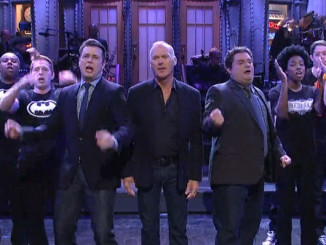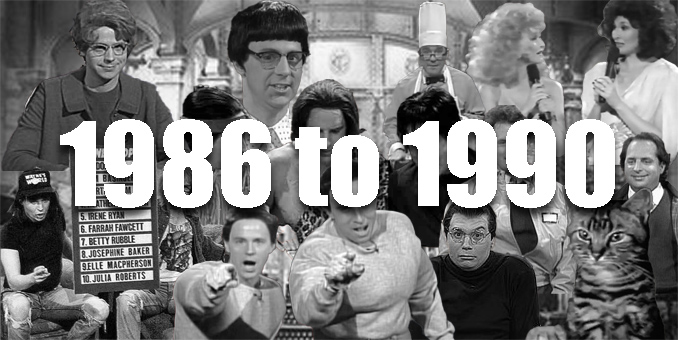
In honor of Saturday Night Live‘s 50th Anniversary, we will be going through its rich and varied history and breaking down its legendary run into easy to digest eras. Some eras might last for years, others only one season. But each era is one that either marked a change in the show, were driven by a remarkable personality of a star, or marked a special part of the history of the program. Today, we cover a return to greatness with one of SNL’s best casts.
At the end of its 11th season, Saturday Night Live was cancelled. It was not coming back. It was only through an intervention by Lorne Michaels and his manager Bernie Brillstein, did it get a reprieve. But Michaels had to agree to be more hands on with the show. And they were keeping it on a short leash. SNL would only get 13 episodes instead of its typical 22. NBC was putting its faith in Michaels again, but not all of it.
Michaels went scorched earth with that season’s cast. The only cast members who were kept were Jon Lovitz, arguably the breakout star of that cursed season, Dennis Miller, whose work on the Weekend Update segment was the year’s only other high point, Nora Dunn, a favorite of Michaels’, and featured player A. Whitney Brown, whose witty Update segments made him worth keeping around. Everyone else was fired.
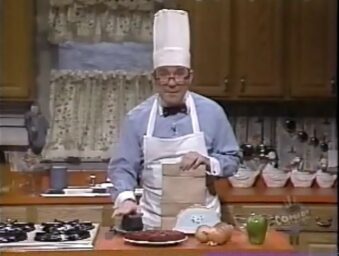
For replacements, Michaels didn’t shy away from known quantities this time around. It would be hard to find unknowns in a day an age where dozens of cable channels came in to every home, comedy clubs were in every city in the U.S. and standup comedians were getting sitcoms left and right. But instead of just fame Michaels chose the cast members for their comedy chops. The new recruits were:
- Dana Carvey: Carvey was a standup comics who already appeared in two TV shows: 1982’s One of the Boys, a sitcom where he costarred with Mickey Rooney, Nathan Lane and Meg Ryan and the 1984 ABC TV adaptation of the 1983 film Blue Thunder. Neither show lasted more than season.
- Phil Hartman: Hartman was a member the California-based improvisational comedy group The Groundlings. He was best known at the time as helping Paul Reubens develop his “Pee-Wee Herman” character and starring as Captain Carl in the stage show that spawned the character and the Saturday Morning show that it spun off.
- Jan Hooks: Hooks also worked at the Groundlings before relocating to Atlanta, Georgia. There, Hooks joined the Atlanta comedy scene and even appeared on TV as part of the repertory of the TBS show Tush, a sketch comedy focused on news personality Bill Tush.
- Victoria Jackson: A Los Angeles comedienne who had appeared on The Tonight Show with Johnny Carson.
- Kevin Nealon: A standup comedian who appeared on The Tonight Show with Johnny Carson and Late Night with David Letterman. He joined the SNL cast as a featured cast member.
Dana Carvey became the breakout star of the new cast. The show’s new emphasis on political humor provided an opening for Carvey’s excellent George H.W. Bush impersonation. But it’s Carvey’s Church Lady that elevated him, and the show.
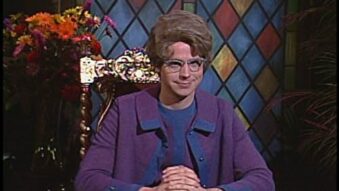
Dressed in drag, Carvey’s Church Lady was a character that many people who went to church knew very well: the pious, holier-than-thou type that judged everyone she came across with. It was the perfect parody at the right time. America was going through a puritan revival. Congressional hearings we being held on “offensive” song lyrics. Powerful televangelists like Jimmy Swaggart and Jim Bakker were ruling the air. The Church Lady was the perfect way to poke fun at this forced morality. And when those televangelists started having sex and financial scandals, the Church Lady was the perfect character to address that as well.
While Carvey was arguably the most popular cast member of this era, the true MVP was Phil Hartman. Hartman was nicknamed “The Glue” by Jan Hooks, and it was a fitting moniker. He held the show together in more ways than one. Do you want hilarious original characters? Hartman would give you the Anal-Retentive Chef and Unfrozen Caveman Lawyer. Need a spot-on impersonation? See Hartman’s Frank Sinatra and Bill Clinton. But where Hartman really excelled was in a support roles in the show. If you needed a father, a talk show host, a detective, or a supporting role in any sketch, Hartman would excel at it. He’d still be funny, but in a way that added to the sketch, not take away from it. And he was also a supportive, uniting force among the cast. Jan Hooks gave him credit for helping her through her stage fright on the show.
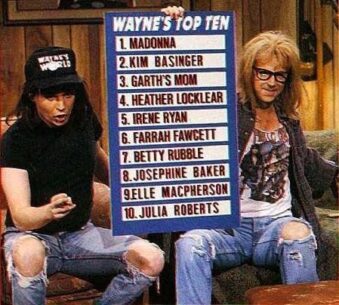
In 1989, SNL added another superstar, Mike Myers. An actor since he was a child in Canada, Myers came to SNL via Second City and he brought a great comedic character with him: Wayne Campbell. “Wayne’s World” became one of the most popular sketches of all time, so popular that it spawned two theatrical films. Myers would also create characters like Dieter from the German talk show Sprockets and Simon, a latchkey British boy.
The era could be called the second Golden Age of SNL. Michaels got a bunch of professionals with great comedy chops who could work together and knew sketch comedy and kept them together so they could be a stable presence every Saturday night.
But good things seldom last forever. The end of this era started on the second to last episode of the 1989-1990 season. This was the notorious episode hosted by Andrew Dice Clay. For those of you not alive back then, “The Diceman” was a big thing at the time. He portrayed himself as a middle to lower class Italian stereotype. A crude and vulgar modern-day macho barbarian whose targets were more often than not women. And the jokes towards women weren’t just pithy observations. They were misogynistic rants that portrayed women as sluts and unworthy of respect.
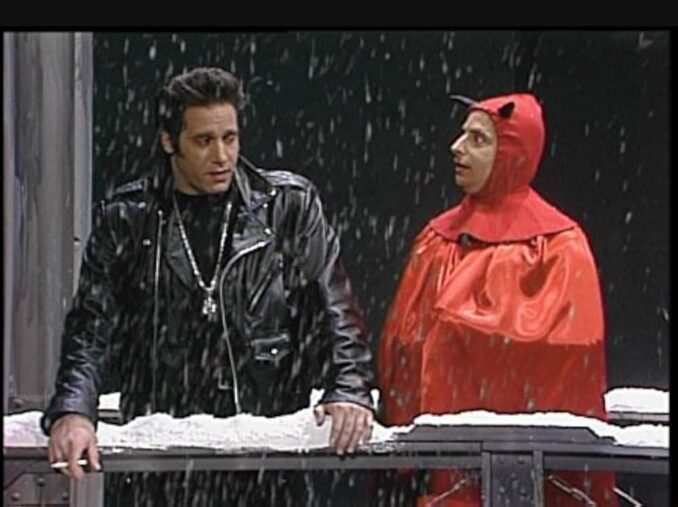
Or at least that was the opinion of cast member Nora Dunn. Offended by Clay’s crude and violent jokes aimed towards women, she decided to boycott the show. Musical guest Sinead O’Connor also dropped out of the show (although she would be the center of her own controversy two years later).
Dunn’s boycott garnered controversy in the press but also among her cast members by the way she announced it. She released a press release announcing her boycott without talking with Michaels, the cast or the writing staff. This means that they were blindsided when the release hit, especially the female members of the cast and writing staff, who had to field questions from reporters and fans about why they didn’t take the same stance as Dunn.
Some in the cast viewed this merely as a publicity stunt by Dunn, whose contract was up at the end of the season. It did get her name in the press and interviewed by major outlets, even in the TV listings, which seldom included such hoohah. But if Dunn was expecting the rest of the country to join her in her boycott she was sadly mistaken. The episode got the highest ratings of the season.
And if Dunn thought the boycott would help her career, she was wrong there too. She left the show at the end of the season, either because of a mutual decision or, as Jan Hooks said in Live From New York: The Complete, Uncensored History of Saturday Night Live as Told by Its Stars, Writers, and Guests, the cast voted her off. Either way, her career after SNL was a series of guest appearances and supporting roles.
While they didn’t know it at the time, Dunn’s departure marked an end of an era. Jon Lovitz, another survivor of Michaels first season back, also left the same time as Dunn due to filming commitments for a motion picture he was cast in. Soon, the rest of this era’s cast would leave, one after another.
But Michaels was prepared. He had a plan to introduce younger cast members who, like Mike Myers, would seamlessly blend into the SNL style and keep the second Golden Age going, However, the group he brought we filled with powerful personalities who turned SNL into a veritable frat house. We’ll talk about them in our next installment.



